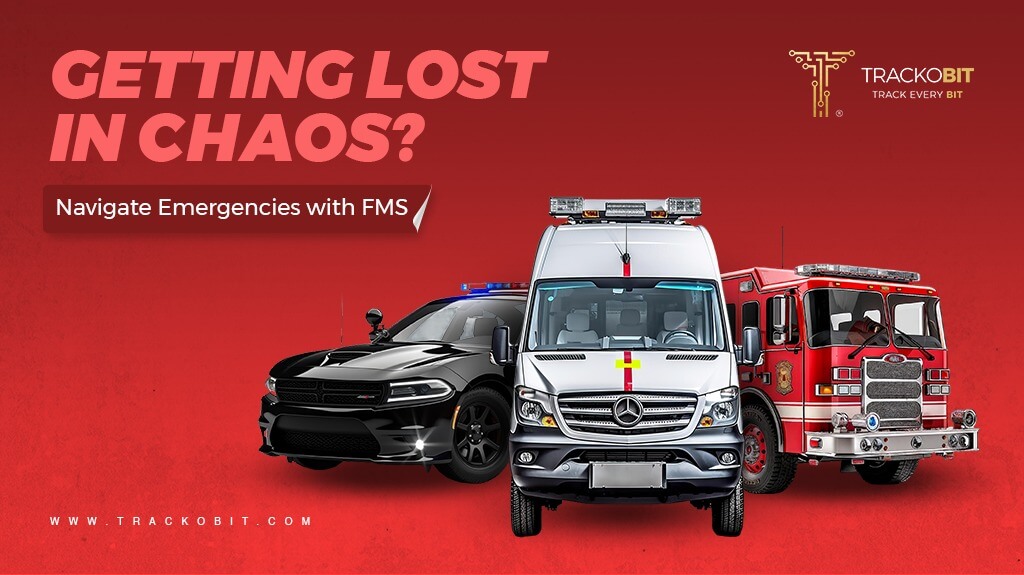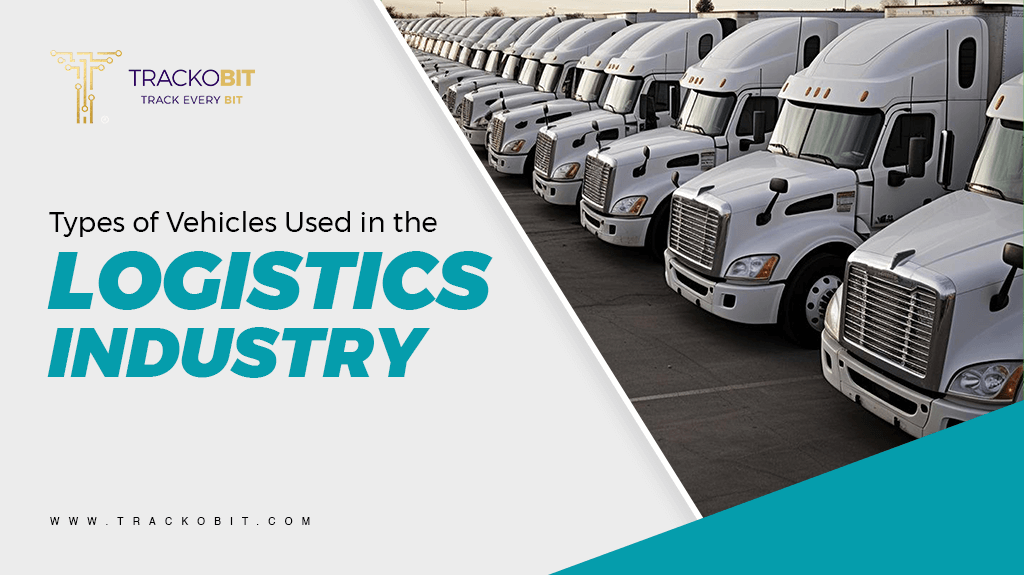-
TrackoBit
Manage commercial vehicles with the new-age Fleet Management Software
TrackoBit -
TrackoField
Streamline your scattered workforce with Field Force Management Software
TrackoField -
Features Resources
About Us
Get to know TrackoBit: our team, ethos, values, and vision.Careers
Join the most dynamic cult of coders, creatives and changemakers.Tech Support
Learn about our technical support team and services in detail.Events
Check out the exhibitions where we left our marks and conquered.
Contact Us
Connect with us and let us know how we can be of service.
How Fleet Management Solutions Cater to Emergency Situations
- Author:
- Read Time:9 min
- Published:
- Last Update: August 30, 2024
Categories
Table of Contents
ToggleCategories
- Video telematics
- TrackoField Industries
- Route Planning
- TrackoMile
- Driver Behaviour
- Last Mile Delivery
- Asset Tracking
- Dispatch Management
- Fuel Management
- Route Optimisation
- Electric Vehicle
- Roster Management
- Vehicle Tracking
- TrackoMile Industries
- TrackoBit Industries
- More
- Sensor Integration
- Topical
- GPS Trackers and Hardware
- Tech and Beyond
- TrackoField
- What's New
- Employee Management
- Company
- Field Sales And Service
- Telematics
- TrackoBit
- Task and Workflow
- Miscellaneous
- GPS Software
- Lead Management
- Fleet Management
- Leave And Attendance

Googling how fleet management solutions cater to emergency situations. Here is a guide that is going to answer all your 5Ws and 1H’s about everything revolving around how the solutions come to the rescue.
Table of Contents
Toggle
Emergencies are a race against time. Precious moments pass as fires spread or medical emergencies intensify, bringing those in need closer to serious consequences.
But what if we tell you fleet management systems can be your secret weapon for faster response times? This powerful tool uses real-time data and smart algorithms to optimize routes, navigate emergency vehicles, and even save on operational costs.
This piece explores what fleet management solutions bring to the table when it comes to use cases in emergencies.
Before we jump on the solutions, let’s analyze emergency service fleets’ challenges.
Challenges of Fleet Management for Emergency Services
Fleet management for emergency services involves unique challenges and critical aspects that must be effectively addressed to ensure timely and efficient response. Below are some of the most common challenges unfolded for you.
-
Time-sensitive nature of emergencies
At the time of emergencies, fleet managers, drivers and vehicles have to run against the clock to address emergency situations. Distance, route, readiness of staff and vehicle condition are some key factors that directly affect the response time. With so many external factors involved, the probability of delay only rises.
The primary concern for emergency fleet managers is to improve response time and route navigation. Here the main concern is not just to reach ASAP but also to act promptly before the problem escalates. For instance, a fire breaks out in a residential area. Delayed reaction or late arrival in such a situation can cost the lives of many, let alone the loss of property.
-
Limited Resources
Limited resources present a considerable challenge for fleet management in emergency services, primarily due to resource allocation difficulties. Operating under strict budget limitations often impacts both the number and quality of vehicles available in the fleet, potentially compromising the effectiveness and reliability of emergency response.
Additionally, efficiently distributing a limited number of vehicles across various locations and types of emergencies becomes a complex task, requiring careful prioritization and strategic planning to ensure adequate coverage and timely response.
-
Safety Concerns
Safety is a major concern in fleet management for emergency services, particularly due to driver fatigue and high-risk situations. Emergency responders often endure long, irregular hours, leading to fatigue significantly increasing the risk of accidents.
Additionally, emergency addressal exposes both the vehicle and the personnel to dangerous conditions, like risky or aggressive driving habits and the emergency situation itself. These hazards not only threaten the safety of emergency responders but also affect the efficiency of the fleet.
-
Vehicle Maintenance
More than a challenge this is a necessity that shall not be compromised. Keeping vehicles in top-notch condition requires regular and timely check-ups, which is hard when they are always in use.
Imagine, a vehicle breaking down unexpectedly in the middle of a trip? Disrupting emergency response and causing delay.
Over time, vehicles get old and less reliable, requiring either expensive repairs or replacements. This all adds up to a lot of pressure on maintaining the fleet.
| Recent Example of Emergency Situation: Wildfire Crisis in California (2023)
In 2023, California faced one of the most devastating wildfire seasons in recent history. Rapidly spreading fires engulfed thousands of acres, threatening homes, wildlife, and human lives. The complexity and scale of the emergency required a coordinated and efficient response from multiple agencies, including fire departments, emergency medical services, law enforcement, and utility companies. The incident mentioned above is one such scenario where an ideal fleet management solution comes greatly into use. |

How Fleet Management Solutions Cater These Challenges
Fleet Management solution is like a ‘Nick Fury’ to our superheroes such as medical emergency fleet, fire fighting fleets, police patrolling fleet and more. It puts together advanced technologies, vital-solutions and real-time insights to optimise fleet operations and mitigate potential challenges.
Let’s explore how these systems help in overcoming the outlined challenges
✅From Maze to Mastermind – Route Planning & Real-Time Tracking
Enhanced coordination through route planning and real-time tracking is pivotal for optimizing emergency response operations. Advanced fleet management solution employ dynamic routing techniques that utilize real-time data to calculate the most efficient routes, thereby reducing travel time and ensuring timely arrivals at emergency scenes.
Geofencing capabilities further enhance coordination by setting virtual perimeters, ensuring vehicles adhere to designated areas or routes.
These systems provide live updates on vehicle status and location, enabling dispatchers to deploy the nearest available unit to emergencies, thereby minimizing response times and improving overall operational efficiency.
📌Read More About Geofencing –What is Geofencing? Types & How It Works?
✅Communication is the Key – Better Communication via Driver Apps & Status Updates
One loose thread in the chain of communication during emergency can lead to unfortunate outcomes. However, a complete, correct and leakproof set of information is a must. That is where software-aided fleet management ensures that critical information such as emergency updates or route changes is updated efficiently, optimizing response times.
Enhanced communication facilitated by driver apps is crucial for streamlining operations in emergency fleet management. These apps enable instant messaging, allowing direct and prompt communication between drivers and fleet managers.
✅Save More Lives, Save More Money: Cost-Efficiency with Fuel Monitoring & Reduced Downtime
With fuel rates fluctuating, deciding a final budget for a fleet’s fuel expenditure is a task. Fuel prices are unpredictable, as are the factors affecting a fleet’s consumption during emergencies.
Fuel monitoring capabilities track fuel usage patterns, providing insights into consumption efficiencies and identifying areas for improvement. Additionally, proactive maintenance scheduling ensures fleet readiness, enhances reliability, and minimizes downtime, allowing emergency services to maintain peak operational efficiency while optimally utilizing resources.
📌Here’s to a Valuable Read- How Fuel Management Software Overcomes 4 Key Challenges?
✅Big Data, Big Decisions – Make Informed Choices with Detailed Analytics
Big data has almost changed the game when it comes to efficient fleet management strategies. No, it’s not like businesses did not use data earlier but today we have ample data.
These systems leverage historical data analysis to scrutinize past emergency responses, identifying trends, patterns, and operational inefficiencies that can be optimized for future incidents.
Detailed analytics track essential performance metrics such as response times, fuel efficiency, and maintenance costs, providing comprehensive insights into fleet operations. These data-driven insights empower decision-makers to make informed choices, enabling continuous improvement and optimization of emergency response capabilities.
✅From Alert to Action: Real-Time Insights for On-Point Response
Fleet management systems ensure fast turnaround times and precise responses in emergency situations through real-time alerts and actionable insights. Real-time alerts notify fleet managers and drivers instantly about emergencies and potential vehicle issues, enabling quick and corrective actions. Actionable insights into fleet performance and resource utilization help evaluate response effectiveness and optimize resource allocation.
By leveraging these features, emergency services enhance operational efficiency, ensuring timely and reliable responses to critical situations, ultimately saving lives and minimizing the impact of emergencies.
Sounds amazing right?
Practical Use Cases of Fleet Management Software during Emergencies
Till now, we have covered the challenges and how fleet management solutions cater to emergencies. But are there any strong practical reasons for investing in this software?
Here’s presenting real-life use cases for better clarity.
USE CASE 1 – Fire Department
Fire departments can easily leverage real-time location tracking and route navigation features in their daily operations. Wondering how? Let us break it down for you.
With real-time location tracking, fire departments can monitor the location of fire trucks in real-time, ensuring the closest available unit is dispatched to an emergency. Whereas for efficient route navigation, they can easily get the locational data of the place they have to reach. This information can be shared in run-time with the help of a driver app which further provides the quickest routes to the destination, avoiding traffic and other delays.
That’s just not all, with fleet management solutions departments can schedule proactive maintenance alerts easily to receive notifications for regular maintenance checks, ensuring that fire trucks are always in optimal condition.
USE CASE 2 – Paramedical Services
Medical services and time management go hand in hand. With ideal fleet-tracking software, medical departments can automate medical mobility and healthcare systems.
Total fleet visibility allows you to allocate the nearest available ambulance quickly and plan the trip efficiently. Wondering how? Relax! We have all the answers.
📌 More details about the paramedical use case – Fleet Management Software Can Help Healthcare Industry
With GPS tracking systems, managers gain real-time insight into the live location of ambulances, allowing them to allocate the nearest available vehicle to an emergency swiftly. This real-time visibility is crucial for reducing response times and ensuring timely medical assistance. This enhanced visibility ensures that ambulance fleets are managed efficiently, improving overall response times and patient care.
This means that as soon as the vehicle reaches this area, the hospital can ensure they are ready to receive the patient. Also if geofences are not handy in run time managers can set ETA’s so that hospitals can plan accordingly on the arrival of the patient.
![]()
| 📌TrackoBit Fleet Management Solution- Your Partner in Cold Chain Monitoring and Beyond
As every drop counts. Ensure the integrity of your pharmaceuticals throughout the supply chain with advanced Cold Chain Monitoring. The solution empowers you to. ✅Prevent spoilage and guarantee maximum potency with real-time temperature monitoring. ✅Reduce overall costs with proactive alerts and route planning ✅Build reliable cold chain supply chains with detailed insights So, ready to revolutionize your pharmaceutical cold chain management? Get in touch today! |
USE CASE 3 – Police Departments
Wonder if you’re on patrol. You flick on the radio and hear dispatch scrambling to find the closest unit. That’s where Fleet Management Solutions come in for police departments – Here’s how they make things smoother.
The department can easily streamline patrol management with real-time location monitoring and respond quickly to incidents. This ensures that the closest available unit is dispatched, reducing response times and increasing efficiency. This allows for better resource allocation and strategic planning, ensuring that the right units are always in the right place at the right time.
By utilizing these systems, police departments can improve their overall effectiveness and provide faster, more reliable service to the community.
That’s not just all departments that get police station-wise reports and reports based on priority with detailed insights and historical data.

| Did you know 💡
The fleet management market is projected to grow at a Compound Annual Growth Rate (CAGR) of 15.5%, from USD 25.5 billion in 2022 to USD 52.4 billion by 2027. This growth is driven by the increasing need for efficient fleet operations, particularly in emergency services. |
Parting Words
Now that we are towards the end of this piece by now you must have understood how fleet management solutions turn chaos into order transforming emergency responses with speed, precision, and efficiency.
So, now if you are looking to supercharge your emergency fleet business and make the management of your fleet go from 10 to 100, you should check out TrackoBit. Get custom solutions to your unique use cases.
Why wait, contact TrackoBit today!
FAQs
-
What exactly does emergency services fleet management mean?
Emergency Services Fleet Management refers to the specialized management of fleets used by emergency services such as police, fire departments, ambulances, and other first responders.
-
What role does technology play in emergency fleet management?
Technology such as GPS tracking, and telematics combined with the power of fleet management software helps in real-time monitoring, data collection, and analysis, leading to more informed decision-making and efficient fleet operations.
-
How does fleet management improve the efficiency of emergency services?
Fleet management enhances efficiency by ensuring optimal vehicle performance, reducing downtime through preventive maintenance, utilizing GPS tracking for quick dispatching, and managing resources effectively.
-
What role does driver training play in emergency preparedness?
Proper driver training ensures that drivers know how to react in emergencies, perform basic repairs, and communicate effectively with the fleet management team.
Anvesha Pandey
Anvesha is a creative content specialist with a strong foundation in communications and media. She thrives in dynamic work environments, particularly within the B2B tech sector. With a keen understanding of the telematics, fleet management, and logistics industry, she has crafted 1000+on page compelling content that resonates with target audiences. Beyond her professional pursuits, Anvesha is a passionate writer and lover of literature. When not immersed in her work you will find her either writing poetries or brainstorming on social issues.
Related Blog Test
-

Tips to Build a Solid Fleet Management Strategy (Beware! It Works)
Nandita Gupta 29 August 2024Running a fleet without strategizing? You are doing it all wrong. Here, note down just 9 ways to form a spectacular fleet management strategy.
-

What is a Digital Tachograph? History, How to Use It & Alternatives
Anvesha Pandey 23 August 2024Read a lot of pieces around digital tachographs? Still not clear with what exactly is this? This piece is for you as it unfolds everything about tachographs.
-

What are DTC Codes? Types & How to Decode Them
Tithi Agarwal 20 August 2024Do you see a blinking check engine light but don’t know what it means or the reason? In this blog, we will learn why deciphering DTC codes is crucial for identifying the issue.
-

Types of Vehicles Used in the Logistics Industry
Nandita Gupta 16 August 2024There are almost 5 types of vehicles used in the logistics industry and you are using just one kind? Explore all the types of trucks and multimodal transportation used to ensure on-time dispatch and delivery of goods.
Thank you for reaching out! We'll speak to you soon.
In the meantime, why not find out more about us, explore our products, or visit our blog?
Stay Updated on tech, telematics and mobility. Don't miss out on the latest in the industry.
Cookie Consent
We use cookies to enhance and personalize your browsing experience. By continuing to use our website, you agree to our Privacy Policy.






























